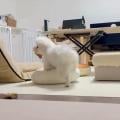NY Issue : Interview with Shantell Martin

ミュージアムやギャラリーでのライヴ・ドローイングに留まらず、ケンドリック・ラマーやMax Mara、メイベリンなどジャンルを超えた多くのコラボレーションでも知られるヴィジュアル・アーティスト、Shaantell Martin。白バックに黒のペンでシンプルにラインを描く彼女のアートは、日本の文化からも大きな影響を受けているという。
——小さいときはどんな子供でしたか?
Shantell「陽気だけど、結構真面目で整理整頓するのが好きだったんです。なぜか、いつも物を整理していたの(笑)。今も子どもの頃と同じだと思います。遊び心もあるけど、きちんとオーガナイズされているというね」
——その頃から絵を描くのが好きだったんですか?
Shantell「ええ、小さい頃からずっとアートを作っています。みんな小さい頃は絵を描いたり、文章を書いたりしていましたよね。やめてしまう人もいるけど、私は続けたんです。多分みんな先生や親に、家や人、犬などのちゃんとした描き方を教わって、自分が描いた絵がお見本と違ったら、下手だと思い込んでやめてしまうんですよね。でも、私は描き続けなくてはいけなかったから続けました。自分の中にある”それ(IT)”を出さなきゃいけなかったから、止められなかったんです」
——いつどうやって自分のスタイルを発見したのか教えてください。
Shantell「スタイルというのはそれぞれの内側にあると思うのですが、私はそれを日本で見つけました。日本にいたことがあって、DJやミュージシャンやダンサーと一緒にライヴ・アートをしていたんです。・だから、考えたり止まったり準備したりする時間はない。とにかく描き続けるのみ。終わってみて、『ああ、これが私なんだ!』って思うようなアートが出来上がっている。その繰り返しで、自分のスタイルが生まれていきました。考える間もない状況で描いてたから、スタイルを見つけることができたんです」
——まさに自分の内側が反映されていたわけですね。その時にラインとモノクロのスタイルを見つけたんですか。
Shantell「子供の頃からモノクロは好きだったんです。そのシンプルさが好きです。カラフルな絵では脳が色を識別するのに比べ、モノクロだとみんな違うところに注目するから、その見られ方も楽しんでいます。私はとても大きな作品を作るんだけど、感想が人によって全然違っていて、さらに見る度に新しいことに気づいていくのがおもしろくて。ラインのおもしろいところは、間違えたり、止まったりしたら、見た人にバレてしまうところ。隠れることができないから、自信を持って描くことが必要なんです。私はほとんどの作品をオーディエンスの前でライヴで描いていますが、そうすることで、アーティストの制作過程や努力についても理解が深まるんじゃないかと思っています。ラインはシンプルだから子供でも描けると思う人もいるかもしれませんが、誰が見ても『これはShantellだ!』とわかるような自分らしいラインを描くことことはとても難しいんですよ。生で描くことで、見ている人にインスピレーションを与えられるといいなと思います」
——さっき見る人によって感想が違うと言っていましたが、あなたの作品はメインの箇所が用意されているわけではなく、全てのラインが等しいように思えます。
Shantell「そう。バラバラのパーツだけれど、全部合わせて一つの大きなアートだと思っています。そこに描いているメッセージもとても重要で、ポジティヴだけど質問になっているものが多いから、私のアートを見た人が自分について考えてくれればいいなと思います」
—— あなたは自分の作品をDNAに例えていますが、その類似性に気づいたのは?
Shantell「ドローイングはアートですが、私はその作業過程自体もアートだと思うんです。だから描くときは、自分がなにをしているかについて考えながら描いています。毎回、最初の一本の線を描く。その一つの線が作品の個性を決めるんです。それぞれの個性を形作るDNAと一本目の線を描くことはとても近しい。毎回描くたびにそう感じます。一つ一つの作品の個性は、最初の線から生まれるんです」

——何を使って描くことが多いですか?
Shantell「主に使うのは2種類のペンです。太いKrinkと細いStaedtlerですね。ペンとステッカーは常に持ち歩いています」
——日本でのライヴペインティングでスタイルを発見したということでしたが、書道にも影響を受けている部分がありますか?
Shantell「ええ。書道は集中力とコントロールが必要なのと同時に、とても自由な表現ができて、その人らしさが出る素晴らしいものだと思います」
——ケンドリック・ラマーとコラボレーションしたライヴ・ドローイングは大変な話題になりました。日本でのライヴの経験がそういうパフォーマンスにも活かされているのでしょうか。
Shantell「まさに日本でコラボレーションについて学びました。日本では、様々なアートをしている人たちが当たり前のようにコラボしていますよね。アメリカやイギリスだと、みんな自分の作品へのこだわりが強いから、簡単にコラボレートができないんです。ヴィジュアルについても学びがありあした。日本ではどのクラブに行っても、ヴィジュアルが印象的でした。今はNYでもあるけれど、私が初めてNYに来た頃はまだクラブで映像は流れていませんでした。日本に行かなかったら、大きなヴィジュアルを作っていなかったと思います」
——学校はセント・マーティンですよね。そこで学んだことはアートにどのような影響を与えましたか。
Shantell「セント・マーティンに通わなかったら、日本に行かなかったと思います。そこで日本人の友達がたくさんできたし、日本の映画やアート、アニメも好きになりました。家族で伝統を受け継いで極めるという教えにもとても感銘を受けました。1000年間、お箸を作り続ける家系があり、練習して、どんどん上達するというような文化に驚いたんです。私もラインを極めて、ラインのチャンピオンになろうと思いました。日本にいたからシンプルなラインに集中し始めたと言えます」
——伝統的であったり極めるということについての考察も持ちながら、同時にデジタルアートにも意欲的ですが、インターネットがアートに与えた影響についてはどう考えていますか。
Shantell「絵が描ければ、何でもできると思うんです。ファッション、テクノロジー、教育、音楽……本当に何とでも繋がれる。デジタルは間違えても訂正したり消したりできるから、失敗を恐れている人にとっては、紙や壁なよりもっと気軽で自由に描けるプラットフォームだと思います。あと、作業を迅速にできると思う。例えば、日本に住んでいた時にクラブの映像を担当していたのですが、ズームイン、ズームアウト、映像を動かすことや、多くの色を使ったりすることがとても簡単に素早くできて助かりました」
——社会におけるアートの役割については?
Shantell「アートは大事だと思います。けれど、『自分はアートに向いてない』と思い込んでいる人が多いものが問題。ギャラリーや博物館にある展示物をイメージしたり、お金持ちの趣味だと思っている人もいるけれど、そんなことはないんです。みんな子供の時にアートを作っているし、アートを作ったら、自分を理解できる。頭の中から湧き出るものがあり、手を動かして、自分の気持ちを表現して、自分のことをもっと知れる。絵を描いたり文章を書いたりしてアートを作らなかったら、どうやって自分のことを知るのでしょう? アーティストになる必要はないんです。子供はみんなアーティストです。子供はみんな絵を描いて、遊んで、自分を発見していく。それと同じことなんです」
——最後に、いま進行中のプロジェクトと最新のニュースがあれば教えてください。
Shantell「今は友達のYouTuberのCasey Neistatと動画を作っています。明日(9月23日)はCooper Hewitt Museumで展示されているテクスタイルについてのトークがあって、10月16日にはデンバーに大きな壁画を描きます。それは3年間残る予定です」
photography Diego Garcia
interview & edit Ryoko Kuwahara
Shantell Martin
https://shantellmartin.art
IG/Twitter
@Shantell_Martin

–So how would you describe yourself as a child?
If I look back, I was very playful, but quite serious, and very organized as a child. A little strange, but I was always organizing everything. It’s the same now. I’m very playful, but also organized. Same as when i was a child.
–Have you been drawing since you were little?
I’ve been making art since I was little. You know, we all have. We’ve all been drawing and writing since we were little. It’s just sometimes, we stop, but I didn’t stop. I continued.
Because it was inside me and it had to come out. I couldn’t stop, you know. Sometimes, in school, the teacher or parent says, “This is a house. This a dog. This is how you draw a person.” But sometimes, if your house or dog doesn’t look the same, you think you can’t draw. But for some reason, I had to keep drawing.
——When did you find and develop your own style?
So we all have our style inside us and I found it really in japan. Because when I was in Japan, I was doing live-drawing, so you know, drawing with a DJ or musician or dancer. But when you’re drawing live you have no time to think, or plan, or hesitate. You just draw and draw and draw. And then when you finish, you think, “Oh, this is me.” And then you repeat and repeat and then do another show and another show and another show… and you extract your own style. So it’s because I was drawing with no time to think about anything else.
——This is a reflection of what was inside of you. So was that when you started focusing on black and white lines?
Even as a kid, I liked black and white. Now, I know I like the simplicity of black and white. And also with black and white, everyone looks in a different place, whereas if its colorful, your brain is like yellow or green or blue. If it’s black and white, everyone looks at a different place. You know, I do these really big drawings maybe 100-200 feet long and everyone says, “Oh, I like this,” or “I like this,” or “I like this.” And everyone says something different and then they see it the next time and they’re like “Ooh, I didn’t see that before!” over time. No one is seeing the same thing and I enjoy that.
And You have to be confident with the line. If you make a mistake or if you hesitate, you see it. I like that you can’t hide. I make most of my art live with an audience. I think it’s very important that the audience sees the artist make the work because they understand the process and they understand it takes a lot of hard work because when I’m drawing, it’s very simple. It’s just a line and people sometimes think, “Oh, children can draw lines.” But what’s really, really, really hard is that you can look at my drawings, and say, “Oh it’s Shantell!” To make a line that looks like you is really hard, so I like to draw live, to maybe inspire people to do the same.
——That’s true. Your work is very distinct. So when do you think your lines started becoming really recognized by others as art?
Umm, I don’t know.
——In your art, is there not one main focus and does every line have equal importance?
Yes, I imagine that it’s one big body of art. So it’s all continuous. It’s separate pieces, but it’s all one big body. It’s all very much the same importance, but also the importance is the message in the art. The messages are very positive, but also include lots of questions, so when people see the body of my art, I want them to think about themselves.
——You often compare your work to DNA, but when and how did you start noticing the similarities?
For me, the art is the drawing, but also the process of the drawing, so when I’m drawing, I’m thinking about the drawing and what I’m doing. And every time I draw, I draw one first single line. This first line is what makes every drawing different. And DNA is what makes us different, so I was like “Ahh everytime I do this one line, this is the DNA.” This is why this drawing is different, this drawing is different and why this drawing is different.

——What kind of tools do you use the most?
Usually mostly two types of pens: A very large krink pen and then one really fine Staedtler. But yeah two, one fat and one thin.
——Do you always carry them around with you?
Yeah mostly, pens and stickers
——So you mentioned that live painting in Japan helped you discover and establish your own style, but Have you been influenced by calligraphy too?
Yes, I love calligraphy because it’s so focused and so technical and lots of control. At the same time, it’s very free and you can see the personality.
——I recently viewed your performance with Kendrick Lamar on YouTube. Have your experiences in Japan affected that and other performances as well?
I think moving to Japan taught me about collaboration. In Japan, it’s like, “Oh, you do music? I draw. Oh great, let’s work together!” It’s very easy and simple. In America or the UK, it’s like, “This is mine,” and I feel like collaboration is a little harder. Japan taught me about collaboration and it taught me about visuals because when I lived in Japan, every club−Ageha, Yellow, Womb, Air, Life…everything−had visuals, but when I came to NY, they didn’t. Now, they have them, but it became later. Also, if I didn’t go to Japan, I wouldn’t have started to do these big visuals.
——What kind of influence did studying at St. Martin’s have on you?
So, if I didn’t go to St. Martin’s, I wouldn’t have gone to Japan. Because when I went to St. Martin’s, I made lots of Japanese friends and I really enjoyed Japanese movies and art and animation. But also, I enjoyed this idea of mastery. Like when a family is making chopsticks for 1000 years or something. You practice, you get better, you practice, you get better. For me, it’s all about perfecting one line. If I can get very good at a line, if I can master a line, you know become the champion of the line. So Saint Martin’s inspired me to go to Japan and Japan inspired me to focus on very simple lines.
——Wow, what you said about mastery is so fascinating. And it’s also interesting how you balance that with your more digital projects.
Because i think the foundation is drawing, but then you can do anything, whether it be fashion, technology, teaching, music, etc.
——So, those connections to various fields are also lines in their own ways.
Yeah exactly!
——What do you think about the influence that digital technology has had on art?
It allows other people to be very free. On digital, you can undo and erase very quickly. Lots of people are scared of drawing on walls or paper, but digital allows them to be more free. It also maybe allows you to work quicker sometimes, and when I lived in Japan, I was doing graphics in the clubs. I zoomed in and out, move around, and used lots of colors. And that was possible in a much quicker way.
——What kind of role do you think art plays in society?
I think art is very important, but we have a problem now because people don’t think art is for them. Sometimes, people think is art for galleries, museums and people with lost of money. It’s not true. We create art when we’re children and I think when people understand that they can make art, they can understand themselves. When you’re making art, it’s coming from your head to your hands and you get to feel your feelings and you get to understand more about yourself. So, if you don’t draw, if you don’t write, if you don’t make art, how can you understand yourself? You don’t need to be an artist. All children are artists. All children draw, all children play and do this because that’s how we get to understand ourselves.
——Any exciting news or information about ongoing projects?
Now, I’m making a movie with my friend Casey Neistat. He’s a famous YouTuber and we’re making a movie. Tomorrow(23th Sep), I’m talking at the Cooper Hewitt Museum. They have some of my textiles in their collection. I’m going to Denver to do one whole block of a mural on the floor. So that’s going be big. From next month, on October 16, for three years.
Shantell Martin
https://shantellmartin.art
IG/Twitter @Shantell_Martin
都市で暮らす女性のためのカルチャーWebマガジン。最新ファッションや映画、音楽、 占いなど、創作を刺激する情報を発信。アーティスト連載も多数。
ウェブサイト: http://www.neol.jp/
- ガジェット通信編集部への情報提供はこちら
- 記事内の筆者見解は明示のない限りガジェット通信を代表するものではありません。












